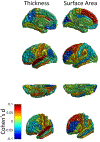No Alterations of Brain Structural Asymmetry in Major Depressive Disorder: An ENIGMA Consortium Analysis
- PMID: 31352813
- PMCID: PMC12038721
- DOI: 10.1176/appi.ajp.2019.18101144
No Alterations of Brain Structural Asymmetry in Major Depressive Disorder: An ENIGMA Consortium Analysis
Abstract
Objective: Asymmetry is a subtle but pervasive aspect of the human brain, and it may be altered in several psychiatric conditions. MRI studies have shown subtle differences of brain anatomy between people with major depressive disorder and healthy control subjects, but few studies have specifically examined brain anatomical asymmetry in relation to this disorder, and results from those studies have remained inconclusive. At the functional level, some electroencephalography studies have indicated left fronto-cortical hypoactivity and right parietal hypoactivity in depressive disorders, so aspects of lateralized anatomy may also be affected. The authors used pooled individual-level data from data sets collected around the world to investigate differences in laterality in measures of cortical thickness, cortical surface area, and subcortical volume between individuals with major depression and healthy control subjects.
Methods: The authors investigated differences in the laterality of thickness and surface area measures of 34 cerebral cortical regions in 2,256 individuals with major depression and 3,504 control subjects from 31 separate data sets, and they investigated volume asymmetries of eight subcortical structures in 2,540 individuals with major depression and 4,230 control subjects from 32 data sets. T1-weighted MRI data were processed with a single protocol using FreeSurfer and the Desikan-Killiany atlas. The large sample size provided 80% power to detect effects of the order of Cohen's d=0.1.
Results: The largest effect size (Cohen's d) of major depression diagnosis was 0.085 for the thickness asymmetry of the superior temporal cortex, which was not significant after adjustment for multiple testing. Asymmetry measures were not significantly associated with medication use, acute compared with remitted status, first episode compared with recurrent status, or age at onset.
Conclusions: Altered brain macro-anatomical asymmetry may be of little relevance to major depression etiology in most cases.
Keywords: Laterality; Left-Right Asymmetry; MRI; Major Depressive Disorder.
Conflict of interest statement
HJ Grabe and B Godlewska received travel grants from Janssen UK. In addition HJ Grabe received research support from Fresenius Medical Care, and from DFG, BMBF, DAMP Foundation. R Bülow received travel grants and speaker honoraria from Bayer Healthcare AG.
Figures

References
-
- American Psychiatric Association t: Diagnostic and statistical manual of mental disorders. 5th ed. Washington DC, USA: 2013.
-
- Biberacher V, Schmidt P, Keshavan A, Boucard CC, Righart R, Samann P, Preibisch C, Frobel D, Aly L, Hemmer B, Zimmer C, Henry RG, Muhlau M. Intra- and interscanner variability of magnetic resonance imaging based volumetry in multiple sclerosis. Neuroimage. 2016;142:188–197. - PubMed
Publication types
MeSH terms
Grants and funding
- P41 RR008079/RR/NCRR NIH HHS/United States
- 104036/Z/14/Z/WT_/Wellcome Trust/United Kingdom
- MR/K022202/1/MRC_/Medical Research Council/United Kingdom
- U54 EB020403/EB/NIBIB NIH HHS/United States
- K23 MH090421/MH/NIMH NIH HHS/United States
- WT_/Wellcome Trust/United Kingdom
- R01 MH059259/MH/NIMH NIH HHS/United States
- K01 MH117442/MH/NIMH NIH HHS/United States
- R37 MH101495/MH/NIMH NIH HHS/United States
- MR/K022202 /MRC_/Medical Research Council/United Kingdom
- R01 MH116147/MH/NIMH NIH HHS/United States
- G0802594/MRC_/Medical Research Council/United Kingdom
- R01 MH085734/MH/NIMH NIH HHS/United States
- R21 AT009173/AT/NCCIH NIH HHS/United States
LinkOut - more resources
Full Text Sources
Miscellaneous

